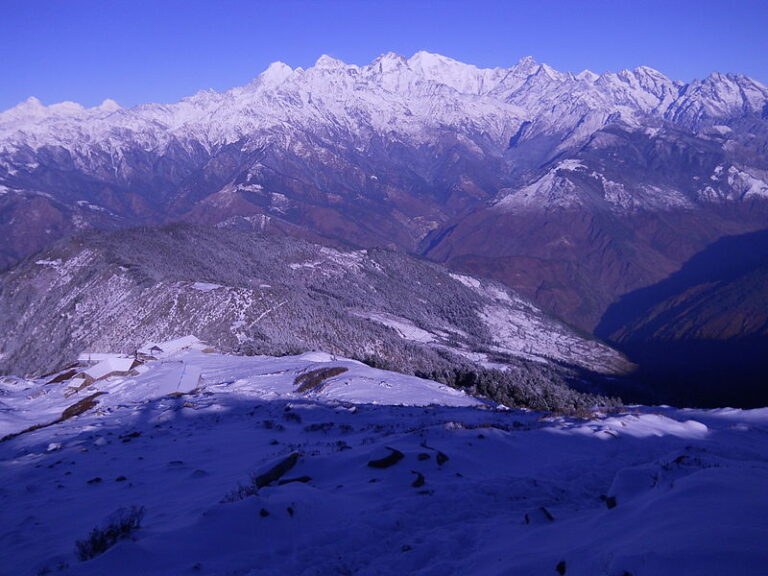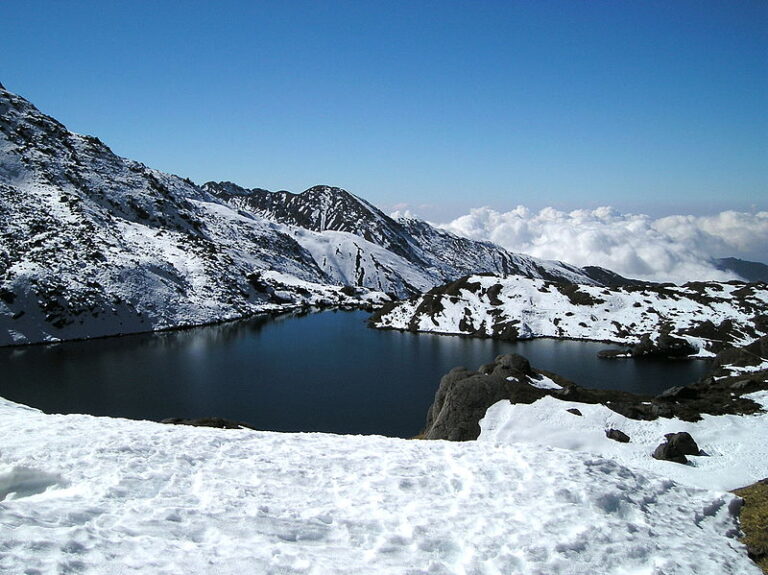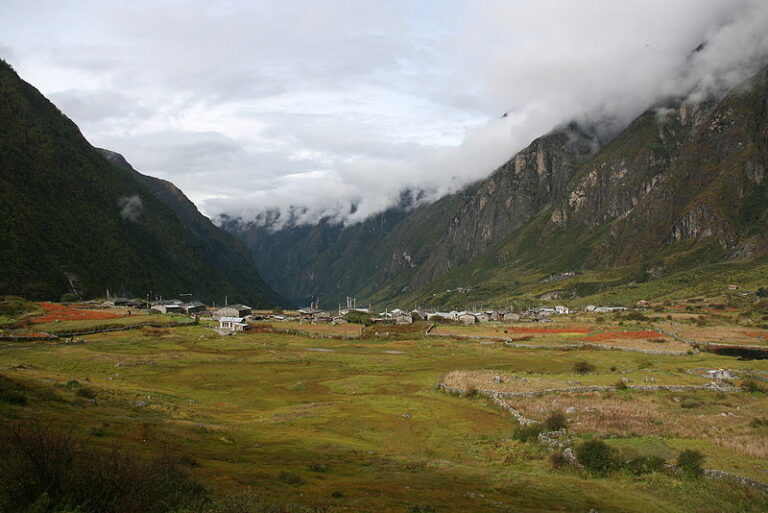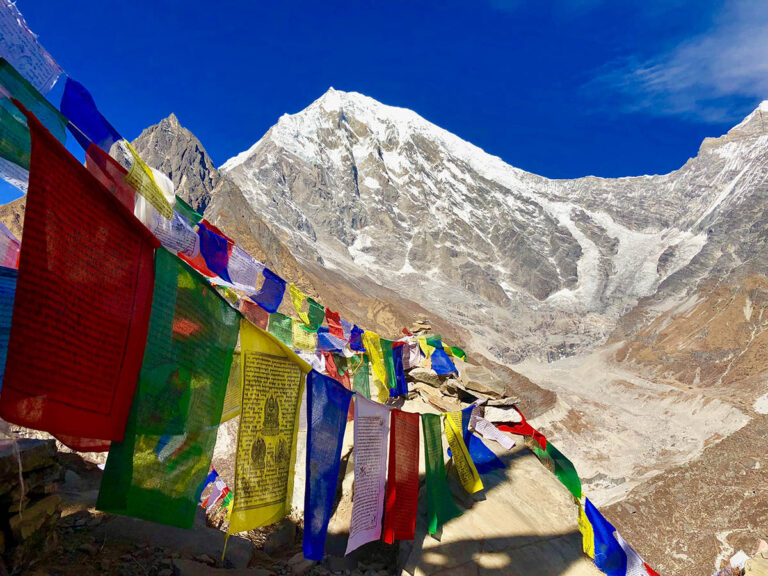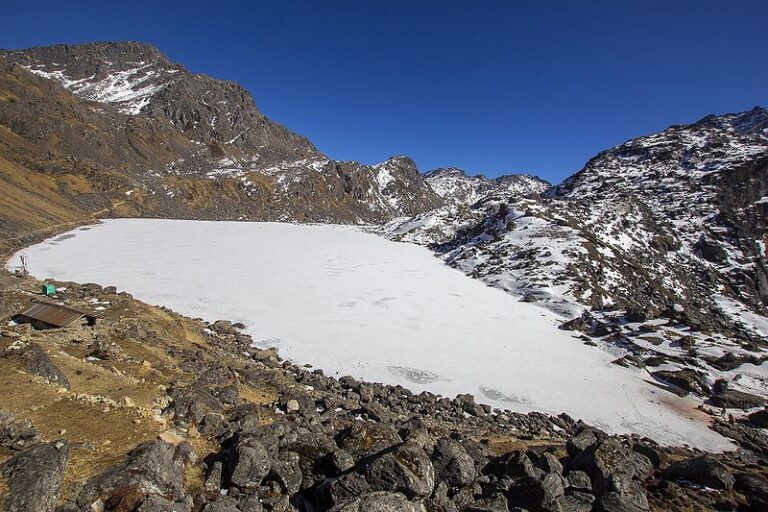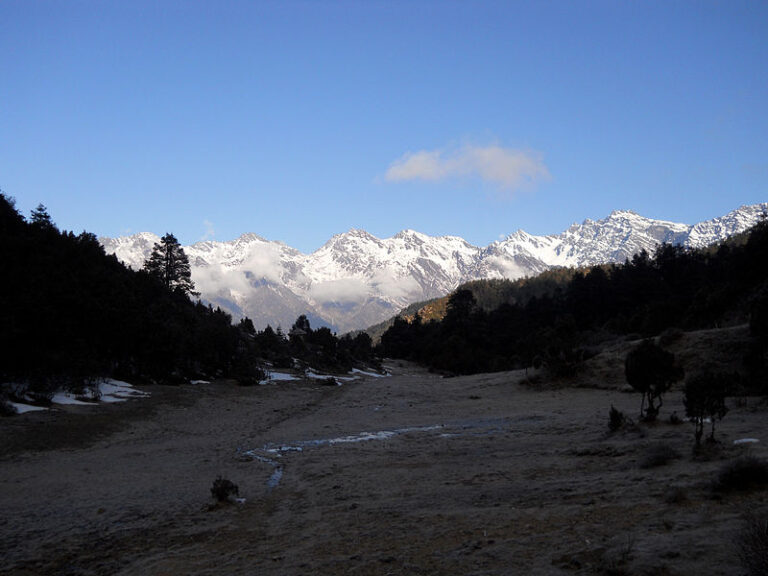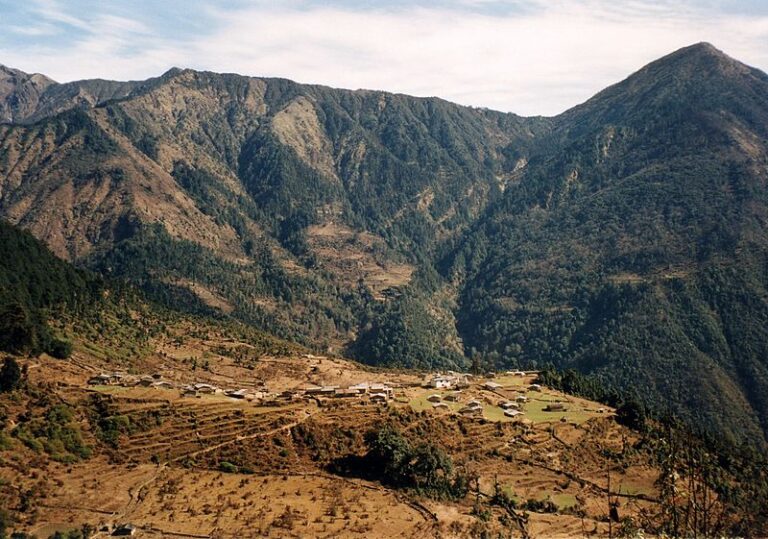Day 01 – Drive to Shyabrubesi 1(500m.a.s.l) -7 hours drives – Shyabrubesi is 120 kilometers far from Kathmandu city and it is one of the entrance gates for the Langtang national park so we have to drive either public bus or private jeep to get Shyabrubesi. The road is an adventurous due to gravel road but still during the driving period, we will see beautiful view of Langtang Lirung, Ganesh Himal, agricultural terraced field and many villages settled over the vertical land.
Day 02 – Trek to Sherpa Gaun (2563m.a.s.l -5 hours walks – Most of the trekkers follow the main trekking trail following by the Langtang River but to trek via Khanjim Village would be pleasant walk, which command us to see beautiful view of snow-caved peaks, verity of landscapes, the gorge of Langtang River, green hill with waterfalls and life style of Sherpa people. Begin of the trek we will ascend about 3 hours to get Bhanjyang danda viewpoint and the rest of the trail is flat and gradual up until Sherpa Gaun.
Day 03 – Trek to Ghodatabela (3030m.a.s.l) -6 hours walks – Early in the morning, we will walk about 2 hours to get Rimche and Lama Hotel village with the view of green landscape and rocky hills. The trail from Lama Hotel to Ghodatabela is mostly climb up through the forest of pine, oaks, bamboo and Rhododendrons so can be seen some wild life like deer, monkeys, mussels and Himalayan Thar. The Ghodatabela is not a settlement, there are only two basic guesthouses are available but still the guesthouses provides bedrooms and meals to the trekkers.
Day 04 – Trek to Langtang Village (3430m.a.s.l) -3 hours walk – Langtang Village is not so far from Ghodatabela, it may take about three hours to get there but still considering by high elevation trek from Ghodatabela to Langtang Village would be enough for the day. Trek from here to Langtang Village is very pleasant walk due to view of Langtang Lirung, Nayakang and its beautiful ranges. There are dozens of guest houses are running in Langtang Village, which are all built after the earthquake.
Day 05 – Trek to Kyanjing Gompa (3830m.a.s.l) -3 hours walks -While we are heading to Kyangjing Gompa Village, we will pass some of the beautiful villages called Mundu and Sindhum, which are, settled just bottom of the Langtang Lirung. Along the trekking trail, there are dozens of Mani-walls, which are built just center of the trekking path. Kyanjing Gompa offers to see awesome view of Langtang Lirung, Yala Peak, and Gangshenpo.
Day 06 – Sight trip to Tserko RI viewpoint (4984m.a.s.l) – 6 hours two way walk – There are many sight trips around the Kyanjing Gompa Village known as Kyanjing Ri view point, Langsisha Kharka, Langtang Lirung base camp but still sight trip to Tserko Ri view point is one of the popular view point around here that command us to see panoramic mountain view of Langtang Lirung, Dorje Lakpa, Gangchenpo, Langsisha, Kinsung, Yala Peak, Nayakang and its beautiful ranges and glaciers.
Day 07 – Trek back to Riverside (2410m.a.s.l ) -6 hours walks – There is not any alternative trail to come back from Langtang Valley so we have to go back via same trail until Rimche Village but still trek will not be board due to see beautiful vista of Langtang Lirung, gurgle sounds of Langtang River and chirp sound of birds. If the trek is in spring season then we can see many kinds of blooming flowers such as Rhododendrons and Orchids.
Day 08 – Trek down to Pahirothopla village (1610m.a.s.l) -5 hours walks – Pleasant walk from Riverside to Pahirothopla leads through the dense forest with the view of rugged rocky hills, vista of Langtang Lirung and charms landscapes. Most of the times we will walk down pass by some villages called Lama Hotel, Rimche, and Bamboo where dozens of teahouses are available and provides meals and basic bedrooms for the trekkers.
Day 09-Trek to Thulo Syabru (2250m.a.s.l) – 4 hours walks – Begin of the trek we will walk about half an hour on the flat trail and the trail ascend through the forest of bamboo, taking by left hand side’s trail. After 1 hour climb up we will reach a small teashop and appear a long suspension bridge and some traditional rice mill. There are dozens of good Guesthouses in the Thulo Syabru village and a beautiful monastery is located just above the village.
Day 10-Trek to Shin Gompa (3330m.as.l) -5 hours walks – The trail gently ascends from the yard of the guesthouse and leads through the agricultural terraced field and tropical forest. Most of the time we will walk on the uphill trail but still trek would be very pleasant due to splendid view of Ganesh Himal 7422m, Langtang Lirung 7227m and far view of Annapurna and Manaslu mountain ranges. Shin Gompa is a small plateau, which is located just top of the hill and surrounded by the beautiful pine and Rhododendron forest and can be explore a beautiful monastery called Shin Gompa.
Day 11-Trek to Lauribinayak (3550m.a.s.l) – 5 hours walks – early in the morning can be seen stunning view of Surya peak 5245m and Chhyarkung chuli 4830 meters to the northern side of Shin Gompa. The trek begin with flat trail and quickly appears fine view of Ganesh Himal then emerging onto a saddle at the tea houses of Cholangpaati then the trail continues to climb to Lauribinayak. There are half dozens of guesthouses are available in Lauribinayak village and offers to see magnificent view of Surya peak, Yugal Himal, Langtang Lirung and far view of Annapurna and Manaslu mountain ranges.
Day 12-Trek to Gosaikunda Lake (4380m.a.s.l) -5 hours walks– Begin of the trek, we will climb bitter uphill trail that may takes an approximately one hour to get the top of the hill that command us to see spectacular view of Ganesh Himal, Langtang Lirung, Surya peak and dramatic view of Annapurna and Manaslu mountain range then the trail lead continuously via on an exposed trail, offering view of swaraswati kunda, Bhairab kunda and finally we will reach in Gosaikunda lake where half dozens of guest houses available around the Gosaikunda Lake.
Day 13-Trek over the Lauribina pass (4610 meters and trek down to Ghopte 3440m.a.s.l) – 7 hours walks – we have to climb up 230 meters to get top of the Lauribina pass. Generally it may take approximately three hours but still may depend on the season, walking speed and our health condition. The top of the Lauribina pass offers to see closer view of Surya peak, Chhyarkung peak and excellent views of the area. After Lauribina pass, we will descend an approximately three hours to get Ghopte with the view of charms landscapes, waterfalls and green forest of Shivapuri national park. There are three guesthouses in Ghopte village and offers comfortable bedrooms and delicious meals with warm Hyalmo hospitality.
Day 14-Trek to kutumsang (2470m.a.s.l) -6 hours walks – begin of the trek, we will walk on the level trail for the half an hour and then the trail ascend to the Tharepati village through the dense forest of Rhododendron and bamboo therefore, along the trekking trail can be seen some wild lives such as monkeys, mussels and many species of birds and butterflies. Tharepati is located just top the hill and offers to see splendid view of Dorje Lakpa peak to the northern side. Trek from Tharepati to Kutumsang may takes an approximately three hours and most of the time we will walk on a rocky path and through the dense forest of Rhododendron.
Day 15 -Trek to Chisapani (2165m.a.s.l) -5 hours walks– today, we will trek down to the Chisapani, which mean (the cold water). Because the area is hided with sunlight and well known as habitant of the Tamang people but still they would like say themselves as Hyalmo by themselves and depending on agriculture so the agricultural terraced field, farming style and tiny villages are would be the major attraction of the day.
Day 18- Trek to Melamchi Bazaar -5 hours walk-most of the time we will walk through the agricultural terraced field and pass by the Tamang village so along the day we will see activities of local people, farming style of the region and green forest which is belongs to Shivapuri national park. There are hundreds of guest houses in Melamchi Bazaar and provide us comfortable bed and delicious meals.
Day 19 -Drive back to Kathmandu -Kathmandu is 29 kilometers far from the Melamchi Bazaar so after breakfast we will drive about one and half hours to get Kathmandu then transfer to the guesthouse to get deep rest.
